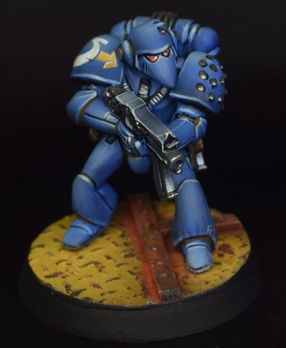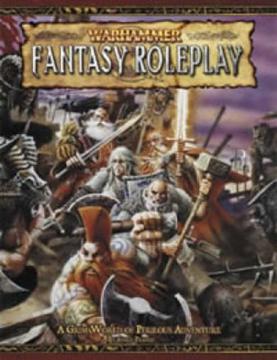
Warhammer 40,000 is a miniature wargame produced by Games Workshop. It is the most popular miniature wargame in the world, and is particularly popular in the United Kingdom. The first edition of the rulebook was published in September 1987, and the tenth and current edition was released in June 2023.

Games Workshop Group is a British manufacturer of miniature wargames, based in Nottingham, England. Its best-known products are Warhammer and Warhammer 40,000.

Talisman: The Magical Quest Game is a fantasy-themed adventure board game for two to six players, originally designed and produced by Games Workshop. The game was first released in 1983 and has gone through three revisions. As of 2021, the fourth edition (2008) is the latest version. The board game sold over 800,000 units by 2000.

Blood Bowl is a miniatures board game created by Jervis Johnson for the British games company Games Workshop as a parody of American football. The game was first released in 1986 and has been re-released in new editions since. Blood Bowl is set in an alternate version of the Warhammer Fantasy setting, populated by traditional fantasy elements such as human warriors, goblins, dwarves, elves, orcs and trolls.

In the fictional universe of Warhammer 40,000, the Space Marines, also known as the Adeptus Astartes, are superhuman warrior-monks who fight for the Imperium of Man. They wear mechanised suits of armour and have modified genomes that grant them superhuman strength and endurance. Some Space Marines have betrayed the Imperium and serve the Gods of Chaos, and are thus known as Chaos Space Marines.

Miniature wargaming is a form of wargaming in which military units are represented by miniature physical models on a model battlefield. The use of physical models to represent military units is in contrast to other tabletop wargames that use abstract pieces such as counters or blocks, or computer wargames which use virtual models. The primary benefit of using models is aesthetics, though in certain wargames the size and shape of the models can have practical consequences on how the match plays out.

HeroQuest, is an adventure board game created by Milton Bradley in conjunction with the British company Games Workshop in 1989, and re-released in 2021. The game is loosely based around archetypes of fantasy role-playing games: the game itself was actually a game system, allowing the gamemaster to create dungeons of their own design using the provided game board, tiles, furnishings and figures. The game manual describes Morcar/Zargon as a former apprentice of Mentor, and the parchment text is read aloud from Mentor's perspective. Several expansions have been released, each adding new tiles, traps, artifacts, and monsters to the core system.

Warhammer is a tabletop miniature wargame with a medieval fantasy theme. The game was created by Bryan Ansell, Richard Halliwell, and Rick Priestley, and first published by the Games Workshop company in 1983.

Warhammer Quest is a fantasy dungeon, role-playing adventure board game released by Games Workshop in 1995 as the successor to HeroQuest and Advanced HeroQuest, set in its fictional Warhammer Fantasy world. The game focuses upon a group of warriors who join to earn their fame and fortune in the darkest depths of the Old World.

Warmaster is a ruleset for tabletop wargames written by Rick Priestley, published by Specialist Games, and set in the Warhammer Fantasy setting. It is different from Warhammer Fantasy Battles in both appearance and gameplay. It is intended for 10 –12 mm miniatures. Basic troops are based on stands, of which typically three make a unit. Generals, Heroes and Wizards are mounted individually or with their retinue.

Battle Masters is a miniature wargame by Milton Bradley, made in collaboration with Games Workshop in 1992. It is thematically similar to Warhammer Fantasy Battle, but with much simpler game mechanics. Like other Milton Bradley/Games Workshop partnership board games HeroQuest and Space Crusade, Battle Masters was designed by Stephen Baker, who later went on to design the popular game Heroscape.

Middle Earth Strategy Battle Game, previously marketed as The Lord of the Rings Strategy Battle Game, The Hobbit: An Unexpected Journey Strategy Battle Game, The Hobbit: The Desolation of Smaug Strategy Battle Game and The Hobbit: The Battle of Five Armies Strategy Battle Game is a tabletop miniature wargame produced by Games Workshop. It is based on The Lord of the Rings and The Hobbit film trilogies directed by Peter Jackson, and the books that inspired them, written by J. R. R. Tolkien.
Marc Gascoigne is a British author and editor. He is the editor, author or co-author of more than fifty books and gaming related titles, including Fighting Fantasy books, Shadowrun novels and adventures, Earthdawn novels and adventures, the original Games Workshop Judge Dredd roleplaying game, and material for Paranoia, Call of Cthulhu and many others listed below.

Graeme Davis is a game designer, writer, and editor in the tabletop role-playing game industry.
Jervis Johnson is an English tabletop game designer. He worked as a designer and manager for Games Workshop for over 38 years, and was the head of its Specialist Games studio. In addition to his work on Warhammer Fantasy Battles and Warhammer 40,000, he created the fantasy football game Blood Bowl, and co-created Epic 40,000, Necromunda, and Age of Sigmar.

Warhammer Fantasy Roleplay or Warhammer Fantasy Role-Play is a role-playing game set in the Warhammer Fantasy setting, published by Games Workshop or its licensees.
Mighty Warriors is an adventure board game created by Games Workshop in 1991 and set in the Warhammer Fantasy fictional universe. The core rules allowed players to explore dungeons, which were randomly generated, and fight monsters, also randomly generated. This was a simplified version of Advanced Heroquest.

Judge Dredd: The Role-Playing Game is a science fiction role-playing game published by Games Workshop in 1985. A second edition was published in 1989.
Richard Fretson Halliwell was a British game designer who worked at Games Workshop (GW) during their seminal period in the 1980s, creating many of the games that would become central to GW's success.













